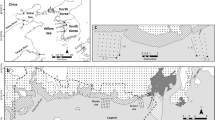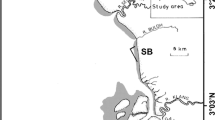Abstract
Available research is inconclusive on how circatidal habitat use and cross-shore distribution of aquatic epibenthic predators may affect the vertical zonation of infauna in muddy, soft-bottom substrates in estuaries. We placed fyke traps at different heights on the intertidal mudflat to assess the circatidal density of epibenthic predators. Infauna was sampled across the same tidal gradient. The abundance of epibenthic predators in the fykes decreased with elevation (decreasing inundation time), yet for the shrimp Palaemon longirostris abundance did not change with elevation in autumn. When corrected for inundation time, predator density was equal over the tidal range or higher on the high mudflat in some instances, indicating that predators evenly distributed over the mudflat or moved to the highest part during a high tide. The density of epibenthic predators did not correlate with the density of infauna, whereas the latter did show a close relationship with sediment characteristics. Our data suggest epibenthic predator density does not shape the present distribution of infauna across the tidal gradient on the oligohaline mudflats in the Scheldt.





Similar content being viewed by others
References
Armendáriz, L. C., A. Rodrigues Capítulo & E. S. Ambrosio, 2011. Relationships between the spatial distribution of oligochaetes (Annelida, Clitellata) and environmental variables in a temperate estuary system of South America (Río de la Plata, Argentina). New Zealand Journal of Marine and Freshwater Research 45: 263–279.
Ashelby, C. W., S. De Grave & M. L. Johnson, 2016. Diet analysis indicates seasonal fluctuation in trophic overlap and separation between a native and an introduced shrimp species (Decapoda, Palaemonidae) in the tidal river Thames (U.K.). Crustaceana 89: 701–719.
Barnes, R. S. K. & M. K. S. Barnes, 2012. Shore height and differentials between macrobenthic assemblages in vegetated and unvegetated areas of an intertidal sandflat. Estuarine, Coastal and Shelf Science 106: 112–120.
Bates, D., M. Maechler, B. Bolker & S. Walker, 2015. Fitting linear mixed-effects models using lme4. Journal of Statistical Software 67: 1–48.
Bertness, M. D., 1981. Predation, physical stress, and the organization of a tropical rocky intertidal hermit crab community. Ecology 62: 411–425.
Campos, J., & H. Van Der Veer, 2008. Autecology Of Crangon Crangon (L.) With An Emphasis On Latitudinal Trends. [available on internet at http://www.crcnetbase.com/doi/abs/10.1201/9781420065756.ch3].
Connell, J. H., 1961a. The influence of interspecific competition and other factors on the distribution of the barnacle Chtalamus stellatus. Ecology 42: 710–723.
Connell, J. H., 1961b. Effects of competition, predation by thais lapillus, and other factors on natural populations of the barnacle Balanus balanoides. Ecological Monographs 31: 61–104.
Connell, J. H., 1972. Community interactions on marine rocky intertidal shores. Annual Review of Ecology and Systematics 3: 169–192.
Cox, T. J. S., T. Maris, K. Soetaert, D. J. Conley, S. Van Damme, P. Meire, J. J. Middelburg, M. Vos & E. Struyf, 2009. A macro-tidal freshwater ecosystem recovering from hypereutrophication: the Schelde case study. Biogeosciences 6: 2935–2948.
del Norte Campos, A. G. & A. Temming, 1994. Daily activity, feeding and rations in gobies and brown shrimp in the northern Wadden Sea. Marine Ecology Progress Series 115: 41–54.
Fretwell, S. D., 1972. Populations in a Seasonal Environment. Monographs in Population Biology, 5th ed. Princeton University Press, Princeton.
Giere, O., 2006. Ecology and biology of marine Oligochaeta—an inventory rather than another review. Hydrobiologia 564: 103–116.
Giraldes, B. W., P. A. Coelho Filho & D. M. Smyth, 2015. Decapod assemblages in subtidal and intertidal zones-Importance of scuba diving as a survey technique in tropical reefs, Brazil. Global Ecology and Conservation 3: 163–175.
Hagerman, L. & J. Ostrup, 1980. Seasonal and Diel Activity Variations in the Shrimp Palaemon adspersus from a Brackish, Non- Tidal Area. Marine Ecology Progress Series 2: 329–335.
Hampel, H. & A. Cattrijsse, 2004. Temporal variation in feeding rhythms in a tidal marsh population of the common goby. Aquatic Sciences 66: 315–326.
Hoffman, J. A., J. Katz & M. D. Bertness, 1984. Fiddler crab deposit-feeding and meiofaunal abundance in salt marsh habitats. Journal of Experimental Marine Biology and Ecology 82: 161–174.
Lesutiene, J., Z. R. Gasiunaite, R. Strikaityte & R. Žiliene, 2014. Trophic position and basal energy sources of the invasive prawn Palaemon elegans in the exposed littoral of the SE Baltic Sea. Aquatic Invasions 9: 37–45.
Levinton, J. S., 1995. Marine biology: function, biodiversity, ecology. Oxford University Press, New York.
Maes, J., L. de Brabandere, F. Ollevier & J. Mees, 2003. The diet and consumption of dominant fish species in the upper Scheldt estuary, Belgium. Journal of the Marine Biological Association of the UK 83: 603–612.
Meire, P., T. Ysebaert, S. Van Damme, E. Van Den Bergh, T. Maris & E. Struyf, 2005. The Scheldt estuary: a description of a changing ecosystem. Hydrobiologia 540: 1–11.
Mialet, B., J. Gouzou, F. Azémar, T. Maris, C. Sossou, N. Toumi, S. Van Damme, P. Meire & M. Tackx, 2011. Response of zooplankton to improving water quality in the Scheldt estuary (Belgium). Estuarine, Coastal and Shelf Science 93: 47–57.
Naylor, E. & S. Rejeki, 1996. Tidal migrations and rhythmic behaviour of sandbeach Crustacea. Revista Chilena de Historia Natural 69: 475–484.
Oh, C. W., R. G. Hartnoll & R. D. M. Nash, 2001. Feeding ecology of the common shrimp Crangon crangon in Port Erin Bay, Isle of Man, Irish Sea. Marine Ecology Progress Series 214: 211–223.
Ólafsson, E. B., C. H. Peterson & W. G. Ambrose Jr., 1994. Does recruitment limitation structure populations and communities of macro-invertebrates in marine soft-sediments: the relative significance of pre- and post-settlement processes. Oceanography and Marine Biology: an Annual Review 32: 65–109.
Paavo, B. L., D. Ham, S. Goerlitz & P. K. Probert, 2012. How does tidal submersion time affect macroinvertebrate community patterns on a temperate sheltered sandflat? Marine and Freshwater Research 63: 68.
Paine, R. T., 1966. Food web complexity and species diversity. The American Naturalist 100: 65–75.
Perez, K. O., R. L. Carlson, M. J. Shulman & J. C. Ellis, 2009. Why are intertidal snails rare in the subtidal? Predation, growth and the vertical distribution of Littorina littorea (L) in the Gulf of Maine. Journal of Experimental Marine Biology and Ecology 369: 79–86.
R Core Team, 2018. R: a language and environment for statistical computing. R Foundation for Statistical Computing. Vienna, [available on internet at https://www.r-project.org/].
Rodrigues, A. M., S. Meireles, T. Pereira, A. Gama & V. Quintino, 2013. Spatial patterns of benthic macroinvertebrates in intertidal areas of a southern European estuary: the Tagus, Portugal. Hydrobiologia 555: 113.
Salgado, J. P., H. N. Cabral & M. J. Costa, 2004. Feeding ecology of the gobies Pomatoschistus minutus (Pallas, 1770) and Pomatoschistus microps (Krøyer, 1838) in the upper Tagus estuary, Portugal. Scientia Marina 68: 425–434.
Salgado, J. P., H. N. Cabral & M. J. Costa, 2007. Spatial and temporal distribution patterns of the macrozoobenthos assemblage in the salt marshes of Tejo estuary (Portugal). Hydrobiologia 587: 225–239.
Seys, J., M. Vincx, & P. Meire, 1999a. Macrobenthos van de Zeeschelde, met bijzonder aandacht voor het voorkomen en de rol van Oligochaeta.
Seys, J., M. Vincx & P. Meire, 1999b. Spatial distribution of oligochaetes (Clitellata) in the tidal freshwater and brackish parts of the Schelde estuary (Belgium). Hydrobiologia 406: 119–132.
Speybroeck, J., N. De Regge, J. Soors, T. Terrie, G. Van Ryckegem, A. Van Braeckel, & E. Van den Bergh, 2014. Monitoring van het macrobenthos van de Zeeschelde en haar getij-onderhevige zijrivieren (1999–2010). Beschrijvend overzicht van historische gegevens (1999, 2002, 2005) en eerste cyclus van nieuwe strategie (2008, 2009, 2010). Rapporten van het Instituut v. Brussel.
Thrush, S. F., 1999. Complex role of predators in structuring soft-sediment macrobenthic communities: implications of changes in spatial scale for experimental studies. Australian Journal of Ecology 24: 344–354.
Van den Bergh, E., T. Ysebaert & P. Meire, 2005. Water bird communities in the Lower Zeeschelde: long-term changes near an expanding harbour 9 10. Hydrobiologia 540: 237–258.
van Haaren, T. & J. Soors, 2013. Aquatic Oligochaeta of the Netherlands and Belgium. KNNV Uitgeverij, Zeist.
Van Ryckegem, G., A. Van Braeckel, R. Elsen, J. Speybroeck, B. Vandevoorde, W. Mertens, J. Breine, G. Spanoghe, D. Buerms, J. De Beukelaer, N. De Regge, K. Hessel, J. Soors, T. Terrie, F. Van Lierop, & E. Van Den Bergh, 2017. MONEOS—Geïntegreerd datarapport INBO: Toestand Zeeschelde 2016 Monitoringsoverzicht en 1ste lijnsrapportage Geomorfologie, diversiteit Habitats en diversiteit Soorten. Rapporten van het Instituut voor Natuur- en Bosonderzoek 2017 (37). Instituut voor Natuur- en Bosonderzoek, Brussel.
Virnstein, R. W., 1977. The importance of predation by crabs and fishes on benthic infauna in chesapeake bay. Ecology 58: 1200–1217.
Wolcott, T. G., 1973. Physiological ecology and intertidal zonation in limpets (Acmaea): a critical look at “limiting factors”. Biological Bulletin 145: 389–422.
Acknowledgements
We wish to thank the Maritime access department for funding the monitoring of benthos. We want to thank all people at INBO and students who assisted with the sampling and sample processing: Dimitri Buerms, De Beukelaer Joram, Lefranc Charles, Soors Jan, Swerts Edith, Terrie Thomas and Van den Broeck Julie.
Author information
Authors and Affiliations
Corresponding author
Additional information
Handling editor: Jonne Kotta
Publisher's Note
Springer Nature remains neutral with regard to jurisdictional claims in published maps and institutional affiliations.
Rights and permissions
About this article
Cite this article
Van de Meutter, F., Bezdenjesnji, O., De Regge, N. et al. The cross-shore distribution of epibenthic predators and its effect on zonation of intertidal macrobenthos: a case study in the river Scheldt. Hydrobiologia 846, 123–133 (2019). https://doi.org/10.1007/s10750-019-04056-5
Received:
Revised:
Accepted:
Published:
Issue Date:
DOI: https://doi.org/10.1007/s10750-019-04056-5




